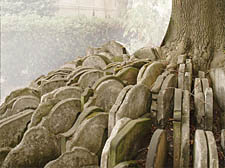|
|
 |
| |
Graveyard shift
A little way behind the station itself, under the shadow of an old, towering ash, a gaggle of gravestones cluster together in a corner of St Pancras Churchyard. The roots of the ancient tree have challenged the headstones’ posture over the centuries; now they tilt a broken smile in the face of advancing years.
The close-knit ring of stone at the tree’s base serves as a timely reminder of the sacrifices made in the name of the station at St Pancras, by those both living and dead.
In the 1860s, construction of the Midland Railway Line into the station ran through part of the St Pancras churchyard. Skulls and thigh-bones lay strewn about during the trial diggings, prompting the Vicar of St Pancras to complain and an eminent architect by the name of Arthur Blomfield was entrusted to oversee the exhumations and dismantling
of tombs.
Blomfield passed this macabre task on to his protégé, a young man named Thomas Hardy. Hardy was studying architecture before he turned his attentions to his much-lauded writing career and the future author spent many hours in the old churchyard in the name of architecture, overseeing the careful removal of bodies and tombs from the land on which the railway was being built.
But unlike the Dickens character Jerry Cruncher in A Tale of Two Cities, written a few years earlier, Hardy was not “fishing” (a 19th-century term for tomb robbery and body snatching) at St Pancras, home to such illustrious corpses as the famous clown Joseph Grimaldi and Mary Wollstonecraft Godwin.
Each of the unearthed bodies was respectfully reinterred, while the headstones were placed harum scarum around the ash tree, leading it to be known as The Hardy Tree.
Sometimes Blomfield would turn up as well and the two friends would pass their sombre watch with the gallows humour they shared. On one shift they discovered a full skeleton with an extra skull – clearly a
two-headed man, they joked.
When the work finished in 1867, an estimated 8,000 dead Londoners had been relocated. The Channel Tunnel works needed more land still, and the St Pancras Churchyard was dug up again, though this time with archaeologists in attendance. Among the bodies, the Archbishop of Narbonne was interred with his mouth of porcelain teeth intact.
Hardy’s graveyard shifts are echoed in some of his poetry. One in particular, “The Levelled Churchyard”, mirrors the situation at The Hardy Tree even though the source of the poem’s inspiration is contested.
With typically morbid humour Hardy imagines (slightly misleadingly) the bodies lying under the gravestones, praying for an end to the restorations:
There’s not a modest maiden elf
But dreads the final Trumpet,
Lest half of her should rise herself,
And half some local strumpet!
From restorations of Thy fane,
From smoothings of Thy sward,
From zealous Churchmen’s pick and plane
Deliver us O Lord! Amen!
Perhaps now – with St Pancras International complete and the lines set in stone – they will finally be able to rest in peace.
SIMON WROE
> Click here to buy your copy. |
|
 |
|
|
 |
|
 |
|








